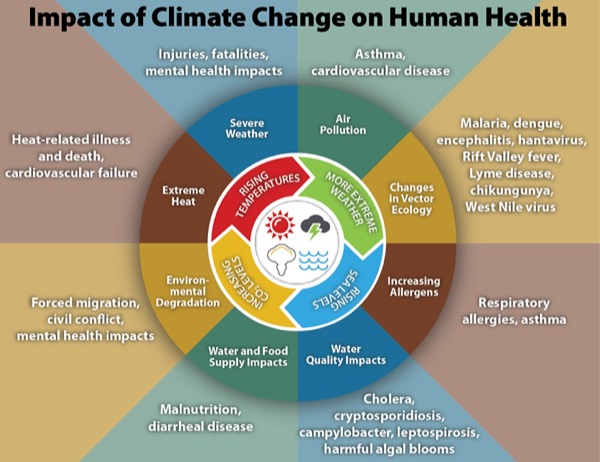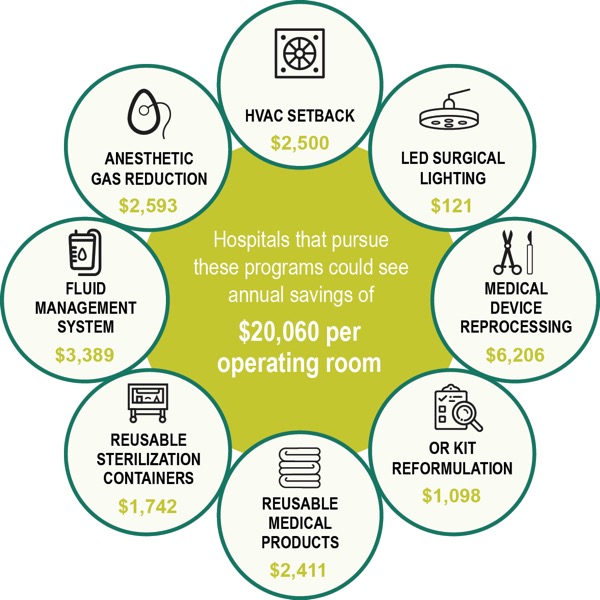By now, many hospitals and patients have experienced the impact of a changing climate: temperature and precipitation extremes, wildfires, hurricanes, flooding and changing disease vectors—many of which have disrupted surgery schedules and adversely affect patient and community health. The ironic reality is that health care, the only U.S. economic sector with an ethical mission to do no harm, is contributing to the problem and responsible for 8.5% of all U.S. greenhouse gas emissions and the loss of 388,000 disability-adjusted life-years in 2018.1 Recognizing this, health professionals are increasingly taking action to promote climate solutions, including climate-smart health care, which is essential to protect public health and our future.2
Extreme Weather and Surgical Care
Extreme weather events, from droughts to severe storms are increasing in frequency and severity. In 2020, the United States experienced a total of 22 unprecedented weather and climate disasters, including the historic wildfires along the West Coast, setting a new annual record.3 Overall, these events resulted in the deaths of 262 people and cost the nation a combined $95 billion in damages, according to the Office for Coastal Management. Such disasters can lead to morbidity and mortality from injuries and illness, and adversely affect the health of surgical patients and the ability to provide safe operative care.
Extreme weather can affect surgical care in other ways. In October 2012, Superstorm Sandy caused a 14-foot storm surge in New York City resulting in power loss, flooding and the forced evacuation of 322 patients at NYU Langone Health.4 Afterward, due to the infrastructure damage, surgery was suspended for two months, and hundreds of providers sought privileges at other hospitals. Temporary closure of other New York City hospitals and relocation of patients caused delays in scheduled surgeries.5 During the extreme cold weather in parts of Texas in February 2021, hospitals canceled urgent and nonurgent surgeries due to heat and water issues related to the unexpected conditions.6 Health care leaders can protect against disruptions to health delivery and improve the organization’s financial viability by preparing their facilities for such weather-related events, and building climate-smart, resilient hospitals.4
Weather events also may disrupt health care supply chains, which can affect surgical care. Puerto Rico is home to major pharmaceutical, medical device and supply manufacturing plants. After Hurricane Maria devastated the island in 2017, U.S. hospitals faced a shortage of normal saline IV bags, pharmaceuticals and surgical devices including hernia mesh, Medtronic surgical staplers, scalpels, Stryker orthopedic instruments and products used in cataract surgery.7
The pandemic raised awareness of the vulnerabilities8 in the health care supply chain and the sector’s dependence on single-use disposable supplies and equipment. Facilities already building resilience into their operations were better positioned to face the challenges of supply shortages experienced during the pandemic. For example, facilities that were already utilizing washable isolation gowns were able to reuse them 75 to 100 times, rather than endure the 2,000% increase in cost during peak demand for single-use disposable isolation gowns.9 Lessons learned from the pandemic and extreme weather events can help advance supply chain resiliency.
Climate-Smart Surgery: Financial, Social and Environmental Benefits
Relative to their physical footprint, ORs make an outsized contribution to a hospital’s climate footprint. Surgery in the United States is very energy-, resource- and waste-intensive, requiring sterilization processes, lighting, cooling and ventilation. ORs consume three to six times more energy per square foot than anywhere else in the facility and generate 30% of a hospital’s overall waste, including two-thirds of its regulated medical waste.10,11 The surgical supply chain is large and expensive, responsible for 40% to 60% of a hospital’s supply chain costs, with recent studies finding that 71% to 82% of health care emissions are derived from the supply chain.2,3 In addition, volatile anesthetic gases, particularly desflurane and nitrous oxide, are potent greenhouse gases that can be responsible for 51% of an OR’s emissions at an average U.S. hospital.10
While surgery’s immense environmental footprint is often considered necessary to provide high-quality care, studies have shown the impact can be reduced without compromising patient safety or quality.12 Recognizing the opportunity to reduce the climate impact of surgical services and costs, many hospitals are taking action and “greening the OR.” Practice Greenhealth reports in its 2020 Sustainability Benchmark Report that hospitals that implemented best practices resulted in a conservative median annual savings of $20,060 per OR, and a median regulated medical waste stream that is 6% of total facility waste.11,13
Scope 3 emissions from the supply chain are the single largest source of greenhouse gases in health care.14 Clinicians are concerned about the footprint of the OR, with surveys finding the majority of surgeons and nurses believe that OR waste is excessive and more supplies should be reused.15,16 Surgeon, anesthesia and nurse leaders have an opportunity to reduce these emissions by making known their preference for and choosing environmentally preferred products and practices, for example:
- selecting reusable or reprocessable rather than single-use disposable products, supplies and equipment9,17;
- reviewing OR kits and preference cards to eliminate unnecessary items18;
- considering anesthetic agent selection19;
- reevaluating surgical approaches, tests, interventions and medications20; and
- considering telehealth for pre-op and follow-up visits.
In addition to the increased efficiency, financial savings and waste reduction from climate-smart programs, environmental stewardship offers a competitive advantage with regard to public image, as well as patient and employee satisfaction. Health care providers understand the serious health threats posed by climate change and feel a responsibility to advocate for strategies that reduce greenhouse gas emissions.21 Corporate social responsibility is a key recruitment and retention strategy for younger health professionals who want to work for organizations committed to protecting the environment. A 2021 Deloitte study among millennial and Generation Z participants found the pandemic had reinforced their desire to drive positive change in their communities and the world, and preferred to stay with their employers longer than five years when those companies prioritized people and environmental sustainability over profits.22
Conclusion
A successful program for greening the OR requires action from all members of the surgical team. Because they are among the most trusted and respected professionals, physicians and nurses have many opportunities to leverage their reputation, influence and health expertise to advance climate solutions in the OR, across their organizations, and with their patients and communities.23 Leadership by example is what is needed to avert the worst climate and health impacts on future generations, and health professionals in the OR have the opportunity to lead the way.
In the next article of the climate-smart surgery series, we will outline the business case for specific environmental best practices in the OR, and provide examples of perioperative professionals driving change.
Dr. Collins is an emergency medicine physician and a senior clinical advisor for physician engagement at Health Care Without Harm, in Boston. Dr. Dilger is a facial plastic and reconstructive surgeon at Massachusetts Eye and Ear Infirmary, in Harwich, and an instructor of otolaryngology-head and neck surgery at Harvard Medical School, in Boston. Dr. Tummala is an ENT physician and a clinical assistant professor of surgery at the George Washington University School of Medicine and Health Sciences, in Washington, D.C. Ms. Moyle is an OR nurse and a sustainability strategy manager at Practice Greenhealth. Ms. Sheehan is the manager of Practice Greenhealth’s “Greening the OR” initiative and a sustainability strategy manager.
References
- Eckelman M, Huang K, Lagasse R, et al. Health care pollution and public health damage in the United States: an update. Health Aff (Millwood). 2020;39(12):2071-2079.
- Health Care Without Harm. Climate and health. Published 2021. Accessed March 24, 2021. https://noharm-uscanada.org/ climateandhealth
- NOAA National Centers for Environmental Information. Billion-dollar weather and climate disasters: overview. Published 2021. Accessed July 21, 2021. https://www.ncdc.noaa.gov/ billions/
- Health Care Without Harm. Extreme weather events are a growing risk to health care margins. Published 2018. Accessed March 24, 2021. https://noharm-uscanada.org/ sites/ default/ files/ documents-files/ 5146/ Safe_haven.pdf
- David-West G, Musa F, Frey MK, et al. Cross-sectional study of the impact of a natural disaster on the delivery of gynecologic oncology care. Disaster Med Public Health Prep. 2015;9(6):605-608.
- Scherer J, Despart Z. Houston hospitals cancel appointments, adjust plans as water pressure plummets. Houston Chronicle. February 17, 2021.
- Thomas K. U.S. hospitals wrestle with shortages of drug supplies made in Puerto Rico. New York Times. 2017;A.
- Yale Office of Sustainability. Covid, climate change, and medical supply chain resiliency: a Q&A with Professor Jodi Sherman, MD. Published 2020. Accessed March 24, 2021. https://sustainability.yale.edu/ news/ covid-climate-change-and-medical-supply-chain-resiliency-qa-professor-jodi-sherman-md
- Baker N, Bromley-Dulfano R, Chan J, et al. COVID-19 solutions are climate solutions: lessons from reusable gowns. Front Public Health. 2020;8:590275.
- MacNeill AJ, Lillywhite R, Brown CJ. The impact of surgery on global climate: a carbon footprinting study of operating theatres in three health systems. Lancet. 2017;1(9):381-388.
- Practice Greenhealth. Greening the OR. Published 2020. Accessed October 9, 2020. https://practicegreenhealth.org/ topics/ greening-operating-room/ greening-or
- Thiel CL, Schehlein E, Ravilla T, et al. Cataract surgery and environmental sustainability: waste and lifecycle assessment of phacoemulsification at a private healthcare facility. J Cataract Refract Surg. 2017;43(11):1391-1398.
- Practice Greenhealth. 2020 Sustainability Benchmark Report. Published 2020. Accessed May 13, 2020. https://practicegreenhealth.org/ tools-and-resources/ latest-sustainability-data
- Eckelman MJ, Sherman JD. Estimated global disease burden from US health care sector greenhouse gas emissions. Am J Public Health. 2018;108(suppl 2):S120-S122.
- Chang DF, Thiel CL, Ophthalmic Instrument Cleaning and Sterilization Task Force. Survey of cataract surgeons’ and nurses’ attitudes toward operating room waste. J Cataract Refract Surg. 2020;46(7):933-940.
- Thiel C, Duncan P, Woods N. Attitude of US obstetricians and gynaecologists to global warming and medical waste. J Health Serv Res Policy. 2017;22(3):162-167.
- MacNeill A, Hopf H, Khanuja A, et al. Transforming the medical device industry: road map to a circular economy. Health Aff (Millwood). 2020;39(12):2088-2097.
- Zygourakis CC, Yoon S, Valencia V, et al. Operating room waste: disposable supply utilization in neurosurgical procedures. J Neurosurg. 2017;126:620-625.
- McGain F, Muret J, Lawson C, et al. Environmental sustainability in anaesthesia and critical care. Br J Anaesth. 2020;125(5):680-692.
- Thiel CL, Eckelman M, Guido R, et al. Environmental impacts of surgical procedures: life cycle assessment of hysterectomy in the United States. Environ Sci Technol. 2015;49(3):1779-1786.
- Lee H, Pagano I, Borth A, et al. Health professional’s willingness to advocate for strengthening global commitments to the Paris climate agreement: findings from a multi-nation survey. J Climate Change Health. 2021;2:2667-2782.
- Deloitte. The Deloitte Global 2020 Millennial and Gen Z Survey. Deloitte; 2020. Accessed May 13, 2021. https://www2.deloitte.com/ global/ en/ pages/ about-deloitte/ articles/ millennialsurvey.html
- Saad L. U.S. ethics ratings rise for medical workers and teachers. Gallup. Published December 22, 2020. Accessed May 13, 2020. https://news.gallup.com/ poll/ 328136/ ethics-ratings-rise-medical-workers-teachers.aspx
This article is from the September 2021 print issue.




